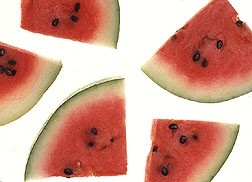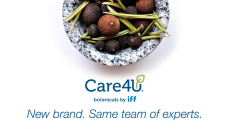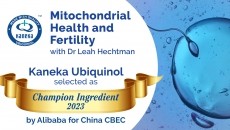New process pits watermelon against tomato as lycopene source
US scientists could challenge tomatoes' pre-eminence as the source
of the antioxidant for foods and dietary supplements.
Lycopene is an antioxidant that is present in red- and pink-coloured fruits and vegetables. As well as being used as a food colouring, it is also used in supplements. The role of lycopene in heart health and in reducing the risk of certain cancers is supported by a body of research.
Scientists from the Agricultural Research Services have previously established that watermelons have a higher lycopene content than tomatoes, the relative difficultly of extracting the nutrient from their flesh and juice has meant that most of the powdered lycopene available on the market comes from tomatoes.
However the work of ARS scientist Wayne Fish could open up a new market in watermelon lycopene - as well as create an outlet for fruits that, for aesthetic reasons, growers are not able sell as whole fruit.
Fish found a way to extract the chromoplasts that encapsulate the lycopene in the fruit without damaging them, meaning that the nutrient is more stable, protected from degradation and has a longer shelf-life.
Precise details of Fish's method were not available at time of publication; and it is not known whether discussions over commercialising Fish's method are in progress.
If it is commercialised, lycopene extracted in this way could well find a home in the swelling numbers of products that seek to pack antioxidants from into foods or beverages with a greater degree of consumer appeal that are designed to help bridge the gap between recommended and actual fruit and veg consumption.
Fish's watermelon lycopene is suitable for processing into powder or paste form. Moreover, Fish says that the process can also be applied to extracting the nutrients from other fruits, such as tomatoes, guava, rosehips and pink grapefruit.
The process' natural claim could give it a further boost, since this term has been seen to resonate with consumers in the current climate where it is regarded by many as healthier and less risky than synthetic or chemical.
Previous ARS research in 2002 found that overall watermelon has as much as 40 per cent more bioavailable lycopene than raw tomatoes - nine to 13mg per cup-and-a-half, although precise levels depend on variety and growing conditions.
The scientists analysed 13 varieties of watermelon for their lycopene content, and found that the seedless varieties tended to have more.
"We think there are a lot of potential uses for watermelon that are just beginning to be explored," said Penelope Perkins-Veazie, author of that study. "It can be a so-called functional food, one that can help prevent certain diseases."
However one factor that could impede the success of watermelon lycopene in the marketplace is the ability of products to make health claims.
The US FDA has approved a claim on tomatoes and tomato-based role in prostate, gastric, ovarian and pancreatic cancer prevention - albeit couched in negative terms that manufacturers would not wish to use on their packaging. But it was not sufficiently convinced by the evidence on lycopene itself.












